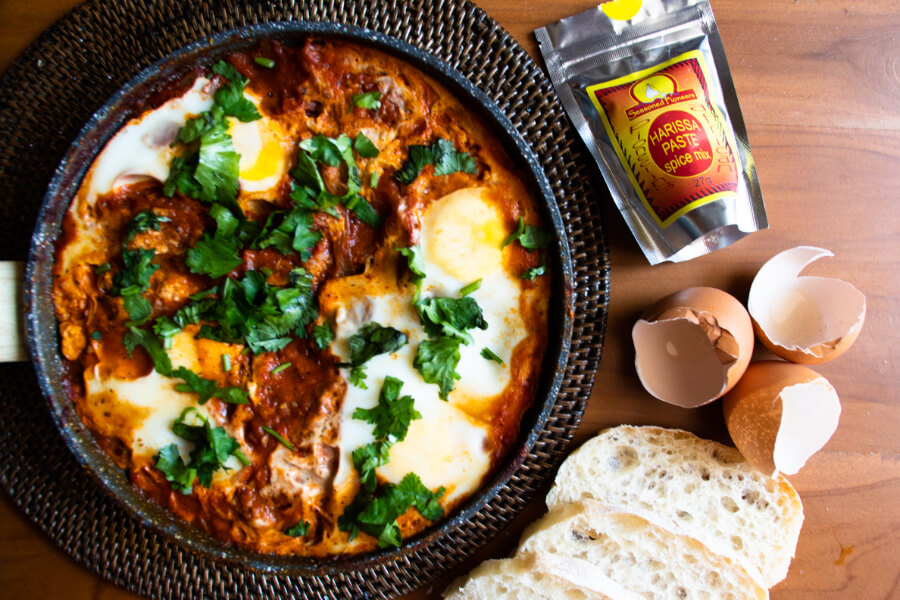A brief history of: Shakshuka
Understanding Spices
Your cart is empty.
SUBTOTAL
£0.00

Understanding Spices
Shakshuka (also spelt with an O, shakshouka), is a staple dish on any Israeli breakfast table. In fact, they eat it at breakfast, lunch and dinner – both at home and in restaurants. The dish is so popular here that it’s considered right up there with falafels and hummus as the best of Israeli cuisine. But how did it get here?
A traditional Shakshuka is a dish of eggs that have been poached in a stew of tomatoes, olive oil, onions and garlic. You’ll commonly find it spiced with cumin, paprika, cayenne pepper and nutmeg. Throw in some herbs and cheese and you’re good to go. It’s often served up in the iron pan it was cooked in, along with some bread for dipping in the sauce and soft, runny egg yolk. Yes please!
The name reflects the way you cook it. Roughly speaking, shakshuka translates to ‘shaken’ or ‘mixed up’ which is essentially what you do to make it. You’re adding things to a pan and nudging them around on a low heat. It’s simplicity and deliciousness, along with its affordability and ability to fill you up, has ensured its popularity throughout Israel and the Middle East for a long time.

Despite this, nobody seems to quite know where it originated from. As always, the origins of the dish are disputed. What we know is that originally, there was an Ottoman dish called ‘Şakşuka’ that was basically cooked vegetables and minced meat. Later on, ‘new world vegetables’ (vegetables arriving via new trade routes) arrived on the scene and were added to the dish. These tomato-based stews were common throughout the Middle East and the former Ottoman Empire – particularly in the Maghreb region (North West Africa).
It was known that Jews living in the Ottoman Maghreb served a vegetarian variation of the dish, while Tunisian Jews were known for their spicy version, including eggs! The trail then goes cold, or rather, nobody really knows how it ended up in Israel. Some believe that the dish spread to Spain and the Middle East from Ottoman Turkey and it’s not hard to imagine this being the case, given how much Menemen you’ll find for breakfast in Istanbul.

Meanwhile, some believe it truly originated in Morocco (where it was cooked in tagines) and others insist it started in Yemen, where it was served with ‘zhug’ – a classic hot sauce featuring throughout Yemeni cuisine. Whatever the true origins, it was eventually brought to Israel by Jewish immigrants from Tunisia, Morocco, Algeria and Libya. At a time when they were struggling financially, this hearty, affordable dish that was very easy to make and made a lot of sense to immigrants. Nowadays, you’ll find it’s just about everywhere! As already mentioned, there are plenty of variations such as Turkish menemen while Tunisians like to add potatoes, broad beans, artichoke hearts and courgettes. There’s also the option of adding in minced meat (just like the origins of the dish) or a spicy bit of chorizo. Here at Seasoned Pioneers, we added our own twist, making use of our Harissa spice mix for this delicious Shakshuka recipe.

Understanding Spices
Spices have long been integral to the UK's culinary landscape, adding depth, flavours, and richness to a myriad of dishes. From the pungent aroma of cumin in Indian curries to...
Read MoreNews
We want to make sure we do everything we can to get your Christmas gifts & ingredients to you in time. Order by the dates below to guarantee that we...
Read MoreUnderstanding Spices
Confetti is an essential part of any wedding day. Not only is it a wonderful way to greet a newlywed couple, but it also provides some beautiful photo opportunities. The...
Read MoreSeasonal Ideas
It’s no secret that any handmade gift will always be more special than a store-bought one. Homemade food gifts are especially wonderful, a labour of love that shows someone you...
Read More